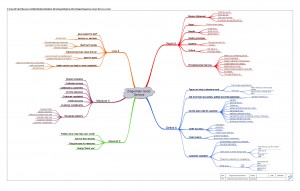“The fundamental idea of iteration (PDCA) is learning. To eschew PDCA is not only arrogant; it is inefficient & often ineffective,” says Shoji Shiba author of Four Practical Revolutions in Management : Systems for Creating Unique Organizational Capability.
The Lean practice of PDCA is ideal for learning and creating knowledge activities. Following this process it allows individuals and teams to recognize and take advantage of opportunities, make decisions faster, and be more responsive to customers. As part of the PDCA cycle you get feedback on the action from listening to customers and the companies’ measurement systems. Having information, taking informed action and getting feedback is part of the natural PDCA cycle. And effectiveness comes from using and taking advantage of all your resources.
When we think of problem solving, we tend to think of a linear progression. PDCA is an iterative process. As we go around the PDCA circle, we improve our knowledge to a point that they we either continue or standardize the work. We can also view the PDCA cycle as a funnel where tighter iterations or the increase in knowledge and collaboration takes place. Repeated use of PDCA makes it possible to improve the quality of the communication, the methodology itself, and the results.
Once set in motion, this process should be an ongoing one, allowing constant interactions between the parties involved. In a learning arena, individuals expand their own knowledge through a “knowledge spiral” (Osterloh and Wubker. 1999). This process has the specific intention of fostering a collective vision among the participants. This vision can assist the development of new solutions for problems in specific subject areas – in this case, the ways in which we deal with the problems our customers are facing and our ability to adjust to new goals and objectives.
During the first stage (Plan) of the PDCA Cycle, the participants interact to appraise the customer needs and information on the subject is made available to all participants, who add it to their own knowledge and experience, and alter this in the light of the new information.
During the second stage (Do), the “influence stage”, participants make critical analysis of their own products/services in light of the new knowledge they have acquired; this broadens their understanding of each other’s needs and abilities. The aim of this stage is to make individuals receptive to new ideas and action. This is maybe the most difficult stage because you have to be receptive to each other’s views and be willing to accept a fresh understanding to solve problems in a new way.
The third stage (Check) is a more intimate stage. An explanation or demonstration of participants’ new level of understanding is essential, measurement. These results that are produced actually can be used and adapted.
The fourth stage (Act) is the act of either continuing down the spiral to another iteration of tighter focus and a more intense cycle deciding that more knowledge is required at this level. Or, that the countermeasures have been introduced and we can standardize for the present time. Think of the spiral as a continuous puzzle of interactions building an ever increasing knowledge of the defined problem for the cycle.
At the 2011 ASQ Lean and Six Sigma Conference, one of the featured speakers was Ari Weinzweig, CEO and co-founding partner of Zingerman’s in Ann Arbor, Mich. The Zingerman’s Community of Businesses (ZCoB) has annual sales approaching $40 million. ZingTrain, a consulting and training company that shares Zingerman’s approach to business with like-minded organizations from around the world, and offers a variety of management training seminars in Ann Arbor, as well as customized workshops and presentations at client sites. I wanted to share my personal experience of Zingerman’s Deli. Besides the great food and great service and catalog littered with special gifts and even more unique food, Zingerman left a special mark on a venture into the retail business that my wife and I did for six years. It was Ari’s book,Zingerman’s Guide to Giving Great Service, that provided our outline for the service that we would provide and train our staff. Below is a mind map of the initial outline that I constructed from the book and what I would call the Zingerman PDCA.

